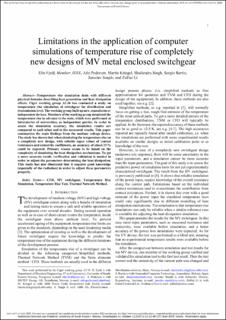| dc.description.abstract | Temperature rise simulation deals with different physical domains describing heat generation and heat dissipation effects. Cigr working group A3.36 has conducted a study on temperature rise simulation of switchgear for distribution and transmission level. The working group built up manufacturer independent devices. Members of the working group simulated the temperature rise in advance to the tests, which were performed at laboratories of universities, as independent parties. In order to assess the simulation accuracy, the simulation results are compared to each other and to the measured results. This paper summarizes the main findings from the medium voltage device. The study has shown that when simulating the temperature rise on a completely new design, with reliable input values of contact resistances and emissivity coefficients, an accuracy of about 25 % could be expected. Primary reason seems to be based on the complexity of simulating the heat dissipation mechanisms. To get a more accurate result, verification and validation is needed in order to adjust the parameters determining the heat dissipation. This study has also illustrated that it requires good knowledge (especially of the radiation) in order to adjust these parameters properly. | en_US |
